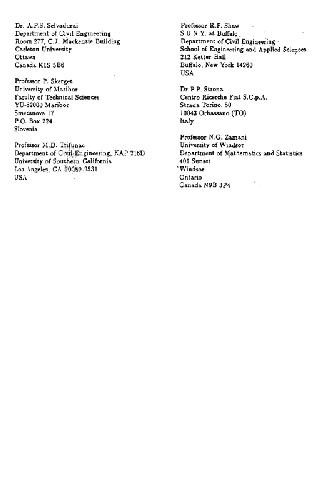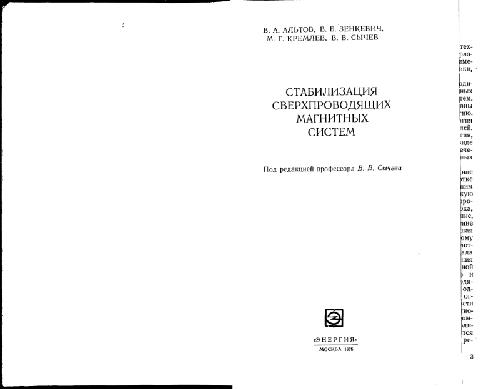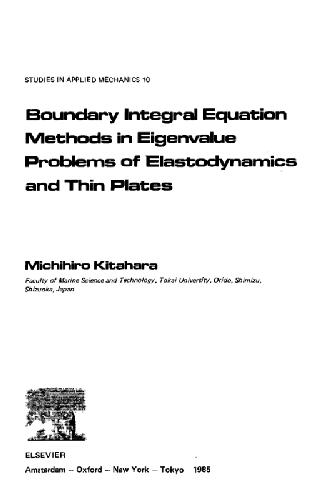S. Het Lin, S. Het Lin, A. A. Villaeys, Y. Fujimura978-981-279-173-3, 981-279-173-6
Special attention is paid to the recent progress of non-linear photon matter interactions in atoms, molecules and interfaces: XUV/soft X-ray, high-order harmonic generation in attosecond regime, high-order harmonic generation, sum frequency generation, four-wave mixing spectroscopy and molecular orientation with combined electrostatic and intense, non-resonant laser fields.
Contents: Nonlinear Optics for Characterizing XUV/Soft X-Ray High-Order Harmonic Fields in Attosecond Regime (Y Nabekawa & K Midorikawa); Signatures of Molecular Structure and Dynamics in High-Order Harmonic Generation (M Lein & C C Chiril ); Molecular Manipulation Techniques and Their Applications (H Sakai); Sum Frequency Generation: An Introduction with Recent Developments and Current Issues (M J Shultz); Propagation and Intramolecular Coupling Effects in Four-Wave Mixing Spectroscopy (J L Paz); Control of Molecular Chirality by Lasers (K Hoki & Y Fujimura).
Table of contents :
Contents……Page 8
Preface……Page 6
1.1. Nonlinear phenomena in XUV/soft X-ray region for ultrafast optics……Page 14
1.2. Autocorrelation measurement……Page 16
2. Generation of Intense Harmonic Fields……Page 18
2.1. Single atom response……Page 19
2.2. Propagation of the harmonic fields with pumping laser field: Phase matching……Page 22
2.3. Development of intense high-order harmonic generator……Page 26
3. Two-Photon Double Ionization……Page 33
4. Measurement of Attosecond Pulse Train with Two-Photon ATI……Page 43
5.1. Similarity of APT with mode-locked laser pulses……Page 58
5.2. Why do we need interferometric autocorrelation?……Page 61
5.3. Two-photon Coulomb explosion……Page 62
5.4. Interferometric autocorrelation……Page 65
6. Summary and Prospects……Page 74
Acknowledgements……Page 76
References……Page 77
1. Introduction……Page 82
2.1. Basic theory……Page 86
2.2. Three-step model……Page 89
2.3. The strong-field approximation……Page 92
2.4. Odd and even harmonics……Page 97
3.1. Ionization step……Page 99
3.2. Recombination step……Page 102
4. Dynamical Effects……Page 110
5. Conclusions……Page 115
References……Page 116
1. Introduction……Page 120
2. Theoretical Background……Page 122
3.1. One-dimensional molecular orientation……Page 123
3.2. Three-dimensional molecular orientation……Page 127
4.1. Optimal control of multiphoton ionization processes in aligned I2 molecules with time-dependent polarization pulses……Page 131
4.2. High-order harmonic generation from aligned molecules……Page 136
5. Summary and Outlook……Page 142
References……Page 143
1. Introduction……Page 146
2. Electric Fields and Orientation Factors……Page 149
2.1. Fresnel factors and propagation direction……Page 154
2.2. Orientation factors……Page 157
2.2.1. Simplification of the orientation tensor……Page 159
2.3. Observed intensity……Page 160
2.3.1. Molecular examples……Page 163
3.1. Absolute orientation determination with a reference……Page 164
3.2. Orthogonal resonances……Page 167
3.3. Null angle……Page 169
3.3.1. Visible angle null, VAN……Page 171
3.3.2. Polarization angle null, PAN……Page 174
3.3.3. Connection with previous work……Page 177
3.3.4. Example……Page 178
4.1. Interfacial optical constants and bulk contributions……Page 181
4.2. Collective modes — a theoretical challenge……Page 184
4.3. Probe depth……Page 187
4.4. Nanoparticle SFG……Page 189
4.5. Time resolution……Page 190
4.6. Surface 2D imaging……Page 191
5.1. Ions at aqueous surfaces: The case for surface H3O+……Page 193
5.2. Interactions at nanostructured interfaces……Page 197
6. Summary……Page 198
A.1 Tensor product……Page 202
References……Page 208
1. Introduction……Page 214
2.1. Study and characterization of FWM signal in the frequency space……Page 219
2.2.1. Propagation effects……Page 228
2.2.2. Topological studies for the FWM signal surfaces……Page 231
2.2.3. Spectra in the frequency space……Page 236
2.3. Approximation levels for the study of the propagation in FWM……Page 239
3.1. Molecular models……Page 242
3.2. Theoretical characteristics of the model……Page 244
3.3. Signal response……Page 246
3.4. Results and discussion……Page 249
4. Final Remarks……Page 254
References……Page 255
1. Introduction……Page 258
2.1. Laser control of an ensemble of racemic mixtures……Page 260
2.2. Photon polarizations of lasers……Page 261
2.3. Density matrix treatment of a racemic mixture……Page 266
3. Control Scenarios……Page 270
3.1. Pump–dump control via an electronic excited state……Page 271
3.2. Control of molecular chirality in a randomly oriented racemic mixture using three polarization components of electric fields……Page 279
3.3. Stimulated Raman adiabatic passage method……Page 288
3.4. Sequential pump–dump control of chirality transformation competing with photodissociation in an electronic excited state……Page 293
4. Conclusions……Page 300
References……Page 301







Reviews
There are no reviews yet.